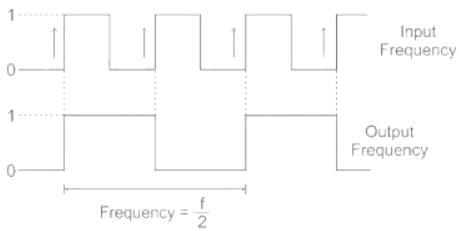Electrical Engineering (EE) Exam > Electrical Engineering (EE) Questions > If the input to a T flip-flop is a 100 MHz si...
Start Learning for Free
If the input to a T flip-flop is a 100 MHz signal, the final output of three T flip-flops in a cascade is
- a)1000 MHz
- b)520 MHz
- c)333 MHz
- d)12.5 MHz
Correct answer is option 'D'. Can you explain this answer?
Most Upvoted Answer
If the input to a T flip-flop is a 100 MHz signal, the final output of...
Explanation:
To understand why the final output of three T flip-flops in a cascade is 12.5 MHz, let's first understand what a T flip-flop does and how it works.
T Flip-Flop:
A T flip-flop is a type of flip-flop that toggles its output based on the input signal. The input to a T flip-flop is called the "toggle" input, and it can either be a logic high (1) or a logic low (0). When the toggle input is high (1), the output of the flip-flop toggles between its current state and its complemented state. When the toggle input is low (0), the output remains unchanged.
Cascade Connection:
When multiple flip-flops are connected in cascade, the output of one flip-flop becomes the input to the next flip-flop. In this case, we have three T flip-flops connected in cascade.
Frequency Division:
Each T flip-flop in the cascade divides the input frequency by two. This means that the output frequency of the first flip-flop is half of the input frequency, the output frequency of the second flip-flop is half of the output frequency of the first flip-flop, and so on.
Calculating the Output Frequency:
Given that the input frequency is 100 MHz, let's calculate the output frequency of the cascade.
- The output frequency of the first flip-flop is half of the input frequency, which is 100 MHz / 2 = 50 MHz.
- The output frequency of the second flip-flop is half of the output frequency of the first flip-flop, which is 50 MHz / 2 = 25 MHz.
- The output frequency of the third flip-flop is half of the output frequency of the second flip-flop, which is 25 MHz / 2 = 12.5 MHz.
Therefore, the final output of the three T flip-flops in a cascade is 12.5 MHz.
Conclusion:
The final output of three T flip-flops in a cascade, when the input is a 100 MHz signal, is 12.5 MHz. This is because each flip-flop divides the frequency by two, resulting in a progressive reduction of the frequency as it passes through each flip-flop.
To understand why the final output of three T flip-flops in a cascade is 12.5 MHz, let's first understand what a T flip-flop does and how it works.
T Flip-Flop:
A T flip-flop is a type of flip-flop that toggles its output based on the input signal. The input to a T flip-flop is called the "toggle" input, and it can either be a logic high (1) or a logic low (0). When the toggle input is high (1), the output of the flip-flop toggles between its current state and its complemented state. When the toggle input is low (0), the output remains unchanged.
Cascade Connection:
When multiple flip-flops are connected in cascade, the output of one flip-flop becomes the input to the next flip-flop. In this case, we have three T flip-flops connected in cascade.
Frequency Division:
Each T flip-flop in the cascade divides the input frequency by two. This means that the output frequency of the first flip-flop is half of the input frequency, the output frequency of the second flip-flop is half of the output frequency of the first flip-flop, and so on.
Calculating the Output Frequency:
Given that the input frequency is 100 MHz, let's calculate the output frequency of the cascade.
- The output frequency of the first flip-flop is half of the input frequency, which is 100 MHz / 2 = 50 MHz.
- The output frequency of the second flip-flop is half of the output frequency of the first flip-flop, which is 50 MHz / 2 = 25 MHz.
- The output frequency of the third flip-flop is half of the output frequency of the second flip-flop, which is 25 MHz / 2 = 12.5 MHz.
Therefore, the final output of the three T flip-flops in a cascade is 12.5 MHz.
Conclusion:
The final output of three T flip-flops in a cascade, when the input is a 100 MHz signal, is 12.5 MHz. This is because each flip-flop divides the frequency by two, resulting in a progressive reduction of the frequency as it passes through each flip-flop.
Free Test
FREE
| Start Free Test |
Community Answer
If the input to a T flip-flop is a 100 MHz signal, the final output of...
Concept:
If we pass the input signal to a single T-flip flop, we will get half of the frequency at the output.


Similarly, when we pass the input signal into an n-bit flip flop counter, the output frequency (fout) will be:

Application:


Similarly, when we pass the input signal into an n-bit flip flop counter, the output frequency (fout) will be:

Application:
Given Input frequency f = 100 Hz

fout = 12.5 Hz

fout = 12.5 Hz

|
Explore Courses for Electrical Engineering (EE) exam
|

|
Question Description
If the input to a T flip-flop is a 100 MHz signal, the final output of three T flip-flops in a cascade isa)1000 MHzb)520 MHzc)333 MHzd)12.5 MHzCorrect answer is option 'D'. Can you explain this answer? for Electrical Engineering (EE) 2025 is part of Electrical Engineering (EE) preparation. The Question and answers have been prepared according to the Electrical Engineering (EE) exam syllabus. Information about If the input to a T flip-flop is a 100 MHz signal, the final output of three T flip-flops in a cascade isa)1000 MHzb)520 MHzc)333 MHzd)12.5 MHzCorrect answer is option 'D'. Can you explain this answer? covers all topics & solutions for Electrical Engineering (EE) 2025 Exam. Find important definitions, questions, meanings, examples, exercises and tests below for If the input to a T flip-flop is a 100 MHz signal, the final output of three T flip-flops in a cascade isa)1000 MHzb)520 MHzc)333 MHzd)12.5 MHzCorrect answer is option 'D'. Can you explain this answer?.
If the input to a T flip-flop is a 100 MHz signal, the final output of three T flip-flops in a cascade isa)1000 MHzb)520 MHzc)333 MHzd)12.5 MHzCorrect answer is option 'D'. Can you explain this answer? for Electrical Engineering (EE) 2025 is part of Electrical Engineering (EE) preparation. The Question and answers have been prepared according to the Electrical Engineering (EE) exam syllabus. Information about If the input to a T flip-flop is a 100 MHz signal, the final output of three T flip-flops in a cascade isa)1000 MHzb)520 MHzc)333 MHzd)12.5 MHzCorrect answer is option 'D'. Can you explain this answer? covers all topics & solutions for Electrical Engineering (EE) 2025 Exam. Find important definitions, questions, meanings, examples, exercises and tests below for If the input to a T flip-flop is a 100 MHz signal, the final output of three T flip-flops in a cascade isa)1000 MHzb)520 MHzc)333 MHzd)12.5 MHzCorrect answer is option 'D'. Can you explain this answer?.
Solutions for If the input to a T flip-flop is a 100 MHz signal, the final output of three T flip-flops in a cascade isa)1000 MHzb)520 MHzc)333 MHzd)12.5 MHzCorrect answer is option 'D'. Can you explain this answer? in English & in Hindi are available as part of our courses for Electrical Engineering (EE).
Download more important topics, notes, lectures and mock test series for Electrical Engineering (EE) Exam by signing up for free.
Here you can find the meaning of If the input to a T flip-flop is a 100 MHz signal, the final output of three T flip-flops in a cascade isa)1000 MHzb)520 MHzc)333 MHzd)12.5 MHzCorrect answer is option 'D'. Can you explain this answer? defined & explained in the simplest way possible. Besides giving the explanation of
If the input to a T flip-flop is a 100 MHz signal, the final output of three T flip-flops in a cascade isa)1000 MHzb)520 MHzc)333 MHzd)12.5 MHzCorrect answer is option 'D'. Can you explain this answer?, a detailed solution for If the input to a T flip-flop is a 100 MHz signal, the final output of three T flip-flops in a cascade isa)1000 MHzb)520 MHzc)333 MHzd)12.5 MHzCorrect answer is option 'D'. Can you explain this answer? has been provided alongside types of If the input to a T flip-flop is a 100 MHz signal, the final output of three T flip-flops in a cascade isa)1000 MHzb)520 MHzc)333 MHzd)12.5 MHzCorrect answer is option 'D'. Can you explain this answer? theory, EduRev gives you an
ample number of questions to practice If the input to a T flip-flop is a 100 MHz signal, the final output of three T flip-flops in a cascade isa)1000 MHzb)520 MHzc)333 MHzd)12.5 MHzCorrect answer is option 'D'. Can you explain this answer? tests, examples and also practice Electrical Engineering (EE) tests.

|
Explore Courses for Electrical Engineering (EE) exam
|

|
Signup for Free!
Signup to see your scores go up within 7 days! Learn & Practice with 1000+ FREE Notes, Videos & Tests.























